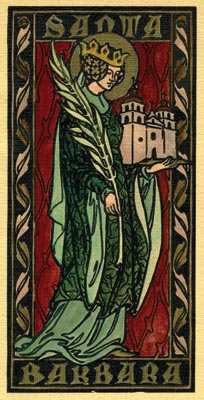What Can You Tell Me About S.B. Artist Robert Hyde?
Robert Hyde Was One of the Founders of S.B.'s Arts and Crafts Colony
During the early 1900s, Santa Barbara was one of California’s major arts and crafts centers. The arts and crafts movement originated in Britain and was introduced to the U.S. in the 1870s. It prized fine craftsmanship, elevating applied and decorative arts to the same level as painting and sculpture. Emphasis was on simplicity of form with motifs drawn from nature. Ideally, the designer and maker of an object were one and the same. The movement was a reaction to the growth of industrialization and its perceived dehumanization. Artisans often looked to the medieval crafts guilds for inspiration; this certainly was true of Robert Wilson Hyde.

Hyde was born in Goshen, Indiana, in 1875. He attended the University of Michigan, where he studied to become a minister. He met Susan McKee, who urged him to pursue his artistic interests. Hyde abandoned his plans for the ministry, and the couple married in 1899. They moved to Chicago, which had become a lively arts and crafts center.
In 1902, the Hydes arrived in Santa Barbara. Here, they found a burgeoning arts and crafts colony. Hyde became good friends with Charles F. Eaton, whose Montecito estate, Riso Rivo, included a crafts workshop of note and who sponsored other artists in the movement.
Hyde’s special interest was the revival of the medieval art of book illumination. Hyde produced one-of-a-kind volumes with leather covers and pages of parchment, written in beautiful Gothic calligraphy and illustrated in luminescent colors. Often the books had hinges of polished brass. He produced wedding albums, guest books, family registers, and special volumes for holidays. As one writer put it, Hyde was adapting “to modern purposes and ideas, the work of the monks of the Middle Ages.”
These volumes, produced in painstaking fashion, were not cheap; a Hyde volume could cost upward of $100. He also made his artistry available in more affordable forms. Note cards sold for as little as 10 cents apiece, and some of his more modest volumes could be had for around $5.
Hyde developed a national reputation. He exhibited at the 1909 Alaska-Yukon-Pacific Exposition in Seattle, San Diego’s Panama-California Exposition in 1915, and at a major arts and crafts exhibition in Boston in 1916. Paul Elder, one of the primary arts and crafts publishers and vendors in California, featured Hyde’s work both in his San Francisco store and the satellite shop he opened in Santa Barbara in 1905.
In 1906, Hyde opened a studio in Eaton’s arts and crafts shop near the Potter Hotel on lower Chapala Street. He also displayed the works of other artists, including Alexander Harmer and Carl Oscar Borg.
In 1910, Hyde left Santa Barbara for a three-year stay in Europe, followed by one year in Washington, D.C. He returned in 1914, and for a number of years had his studio in the Hill-Carrillo Adobe in the first block of East Carrillo Street, before relocating to 312 East Canon Perdido Street.
Hyde became an important figure in the city’s cultural life. He helped found the Community Arts Association in the early 1920s and was a key supporter of Arthur Farwell, whose initiative led to the establishment of the Santa Barbara School of the Arts. Hyde was also instrumental in the discussions leading up to the opening of the new Lobero Theatre in 1924. He took part in area theatrical productions and lent his talents to set design. His door was always open to those who shared his interest in the enrichment of Santa Barbara.
Hyde died at his home on Salsipuedes Street in 1951. His son, Bobby, became well-known in the area as the founder of the Mountain Drive community. Santa Barbara’s arts and crafts colony had been one of great vitality; Robert Wilson Hyde had been one of its architects.



